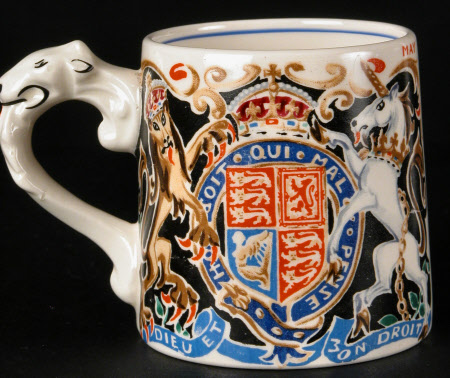Mug to commemorate the coronation of King Edward VIII, later Duke of Windsor (1894-1972)
Burleigh Ware
Category
Ceramics
Date
Unknown
Materials
Ceramic
Measurements
80 mm (Height)
Order this imageCollection
Arlington Court, Devon
NT 985467.1
Caption
‘I am thankful to have known the tasks and struggles of common life, joy and despair like any other mortal. I am just a hard-working woman who longs to pierce the mystery of form and colour.’ These powerful lines appear in Laura Knight’s second autobiography, The Magic of a Line, published to coincide with her large retrospective exhibition (the first of its kind for a woman) at the Royal Academy of Arts in 1965. During the course of an extraordinarily productive career spanning over seven decades, Knight was one of the most distinguished artists of her day. She portrayed a diverse range of sitters, from staff and patients at a racially segregated hospital in Baltimore in the USA, and members of the Women’s Auxiliary Air Force, to subjects from the worlds of the circus, ballet and theatre. On seeing his finished portrait, an astonished George Bernard Shaw told Knight that she made him appear to be a sincere man, ‘when all my life I have been an actor’. During the Second World War, under commission from the War Artists’ Advisory Committee chaired by the art historian Sir Kenneth Clark (1903–83), she often argued that she should be better remunerated. Educated at a time when studying life-drawing was the preserve of male artists, Laura Knight overturned the social restrictions of the day by establishing her own life studio. Hers was a career of firsts: the first woman artist to be made a Dame of the British Empire in 1929, and in 1936 the first woman elected to full membership of the Royal Academy since founding members Angelica Kauffman and Mary Moser in 1768. Throughout Knight’s professional career she worked in a wide variety of media. In the 1930s she was commissioned to design commemorative ceramics, including a mug for Burgess & Leigh Ltd to celebrate the coronation of Edward VIII. The same year, Wedgwood’s Etruria factory commissioned her to produce a loving cup, the design later adapted for the coronation of George VI. Instead of using more traditional tropes of royalty, she portrays a circus elephant – symbolising the British Empire – opposite St George and the Dragon. Towards the end of her long life she stated, ‘my inner self continues to say even today – go on, keep on trying something different’.
Summary
One of a pair of coronation mugs by Dame Laura Knight for Edward VIII and George VI and Queen Elizabeth. Burleigh ware.
Makers and roles
Burleigh Ware, potter Dame Laura Knight (Long Eaton, Derbyshire 1877 – St. John’s Wood 1970)
References
Conroy, Rachel, Women Artists and Designers at the National Trust, 2025, pp. 204-207

